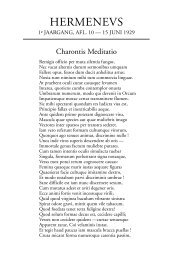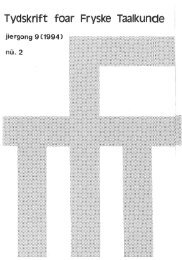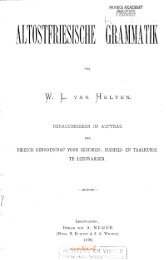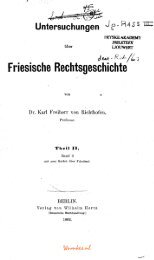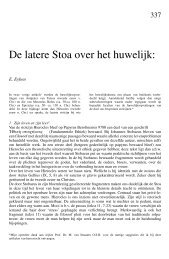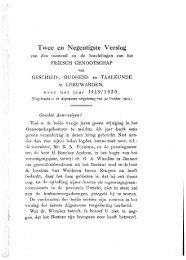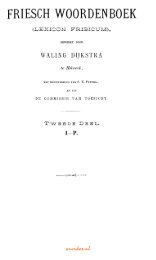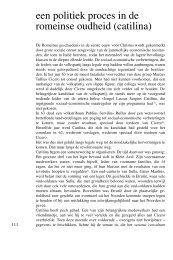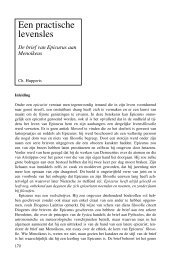It wurk fan Gysbert Japix n-2 - Tresoar
It wurk fan Gysbert Japix n-2 - Tresoar
It wurk fan Gysbert Japix n-2 - Tresoar
Create successful ePaper yourself
Turn your PDF publications into a flip-book with our unique Google optimized e-Paper software.
The additional work by GJ himself concerns mostly texts which Gabbema had<br />
received from the poet. Certain agreements in catchwords and running heads leave<br />
no doubt that the edition goes back to a copy of the 1668 edition.<br />
There may have been various reasons for the edition of 1681. Gabbema himself<br />
says that there was an "unbearable desire" for a second impression, which he is willing<br />
to edit for the honour of Friesland and for the benefit and enjoyment of the rest of<br />
The Netherlands. His appreciation concerns both language and literature. Trough<br />
dedicating the book to the States of Friesland and the stadtholder, he made its publication<br />
a provincial concern. Links with Vulcanius placed it in the humanistic tradition.<br />
If GJ had not yet become a classic poet, Gabbema made him into one with<br />
this edition.<br />
The issue of 1684 is a remaindered part of the 1681 edition, provided with a reset<br />
first quire and a new titlepage for volume II in order to suit the new publisher's imprint.<br />
Perhaps the work sold better in the university town of Franeker, where the new<br />
publisher lived, than in Leeuwarden, the place where the first edition was<br />
published.<br />
Readers (3.2)<br />
In order to collect data about the nature and size of the interest in the work, particularly<br />
up to 1822,1 have traced down and investigated household inventories, auction<br />
catalogues and copies of FR editions. In each case, all available particulars are<br />
reported, such as names of owners or, where appropriate, imitators of GJ's work,<br />
prices, hand-written notes, and - albeit less thoroughly - the physical appearances of<br />
the book.<br />
On the basis of these surveys the editions of 1668 and 1681 can be estimated as having<br />
consisted at most, of a hundred and two hundred copies, respectively. An analysis<br />
of antecedents and statements of those who owned or copied GJ's work before<br />
1822 suggests that it was valued as literature, as a specimen of the Frisian language<br />
and as a symbol of the Frisian culture.<br />
Even while GJ was still alive, it appears from imitations that the Friessche Tjerne<br />
(1640) was an instant success. With respect to education interest was restricted<br />
mainly, but not entirely, to academies. This can be accounted for partly by the character<br />
of the source material. With respect to class it is notable that the Frisian nobility<br />
was well represented. Although the number of subscribing farmers was very small<br />
in 1821, the figure is still favourable in comparison to the number of farmers on other<br />
subscription lists. GJ's works never achieved mass popularity, not even in the nineteenth<br />
century when attempts were made to present him as a poet of the people. Even<br />
by 1700 a considerable number of the indications of the melodies had become<br />
obscure.<br />
Life and world (4)<br />
With the heading 'Life and world' I intend to distinguish between conditions of<br />
life and outlooks on life, that is to say, between origin, education, work, family,<br />
friends and acquaintances on the one hand, and religion, politics and (literary) culture<br />
on the other. As straight statements on these subjects are absent, GJ's opinions<br />
must be deduced from circumstancial evidence. The advantage of a method which<br />
512<br />
wumkes.nl





